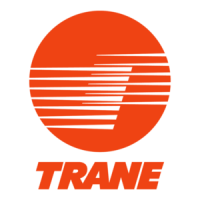
Do you have a question about the Trane IntelliPak SFHK Series and is the answer not in the manual?
| Refrigerant | R-410A |
|---|---|
| Compressor Type | Scroll |
| Efficiency | High |
| Voltage | 208/230V, 460V, 575V |
| Dimensions | Varies with model |
| Weight | Varies with model; consult product data for specific weight |
Overview of IntelliPak units with CV, VAV, or SZVAV controls.
Discusses environmental concerns related to refrigerants and ozone layer.
Outlines Trane's stance on responsible refrigerant handling and technician certification.
Emphasizes mandatory PPE use during installation and servicing due to hazards.
Warns about ensuring adequate structural roof support to prevent collapse.
Advises on precautions when handling fiberglass wool due to potential health risks.
Provides first aid procedures for eye and skin contact with dust.
Describes the manual's content, covering installation, start-up, operation, and maintenance.
Details initial inspection steps upon unit arrival at the job site.
Warns against walking on the sheet metal drain pan to prevent falls.
Provides guidelines for storing the unit to prevent condensate formation.
Describes the first digit of the model number indicating the unit type.
Explains the second digit defining the unit's primary function.
Details the digits representing the unit's nominal cooling capacity in tons.
Explains the digits indicating the unit's power supply specifications.
Explains the digits that specify the system control type like CV, VAV, SZVAV.
Details the digits that specify the exhaust/return fan configuration.
Explains the digits related to the exhaust air fan drive and its RPM.
Covers various miscellaneous digits in the model number that define unit features.
Provides a list of abbreviations and their definitions used throughout the manual.
Describes the basic configuration of Trane commercial rooftop units.
Explains the function of the Rooftop Module in controlling unit operations.
Describes the operation of SCM & MCM compressor modules for mechanical cooling.
Explains the HI module's function for operator interaction and parameter adjustment.
Details the Heat module's role in controlling heating stages or modulating valves.
Describes the MDM for modulating dehumidification control, including reheat and cooling valve control.
Explains the VOM's function in initiating specified ventilation operations.
Details the IPCB's role in expanding UCM network communications to a remote panel.
Explains LCI/BCI modules for communication with automation systems.
Describes the VCM's function in monitoring and controlling fresh air quantity.
Details sensors and controls for CV, SZVAV, and VAV unit types.
Explains motor protection via internal line break overloads for CSHD compressors.
Describes the discharge line thermostat's role in protecting compressors from overheating.
Explains the feature to prevent freezing of hydronic heat coils.
Describes how supply air temp sensor modulates economizer damper.
Details the IntelliPak platform's support for SZVAV as an optional control type.
Describes how the unit operates during occupied cooling periods.
Explains occupied heating operation sequences, staged and modulated.
Discusses operation for CV, SZVAV, and VAV unit types.
Explains RTM's use of duct pressure transducer for supply fan speed control.
Details initial inspection steps upon unit arrival at the job site.
Warns against walking on the sheet metal drain pan to prevent falls.
Provides guidelines for storing the unit to prevent condensate formation.
Illustrates minimum operating and service clearances for unit installation.
Provides data on unit dimensions and weights for different configurations.
Shows minimum operation and service clearances for single unit installations.
Depicts minimum operation and service clearances for multiple unit installations.
Illustrates SAHL unit dimensions and references related tables.
Shows dimensions for SEHL, SFHL, SLHL, SSHL, SXHL units and references tables.
Details components of Trane roof curbs and ductwork installation recommendations.
Explains the recommended location for pitch pockets for power supply entry.
Provides instructions for ductwork attachment when a factory curb kit is not used.
Covers procedures and safety for rigging and placing the unit.
Lists general requirements for successfully installing a commercial rooftop unit.
Outlines requirements for the main electrical power supply connection.
Guides on completing field wiring connections for control systems.
Specifies requirements for electric heat units, including SEHL models.
Details requirements for gas heat units, including piping and flue assembly.
Outlines requirements for hot water heat units, including piping and valve installation.
Covers requirements for steam heat units, including piping and valve installation.
Provides instructions for installing the O/A pressure sensor and tubing.
Details procedures for removing fan shipping channels for motors >5 HP.
Explains the installation of the Outside Air Pressure Sensor and pneumatic tubing.
Provides instructions for removing fan shipping brackets from evaporative condensers.
Covers installation of make-up water and drain lines for evaporative condensers.
Details installation requirements for gas heat units, including gas piping and safety.
Guides on connecting the gas supply line to the furnace gas train.
Provides instructions for installing the flue assembly and its extension.
Outlines installation procedures for hot water heat units and piping.
Covers installation procedures for steam heat units and piping.
Explains the operation and locations of the disconnect switch handle.
Details installation requirements for electric heat units, including power wiring.
Covers requirements for sizing and installing the main unit power wiring.
Provides guidelines for installing wiring for 24 VAC controls.
Offers guidance on wiring for DC analog input/output signals.
Explains the function and wiring of the emergency stop switch.
Details the use of field-supplied contacts for night setback control.
Describes the use of a switch for limiting electrical power usage during peak periods.
Explains the function of the outside air sensor for temperature input.
Shows wiring for ventilation override binary outputs in CV control.
Provides notes for field connection diagrams in CV or VAV applications.
Lists general checks for successful installation of a commercial rooftop unit.
Outlines requirements for the main electrical power supply connection.
Guides on completing field wiring connections for control systems.
Details requirements for gas heat units, including piping and flue assembly.
Outlines requirements for hot water heat units, including piping and valve installation.
Covers requirements for steam heat units, including piping and valve installation.
Provides instructions for installing the O/A pressure sensor and tubing.
Explains the sequence of operations for cooling, including compressor and fan control.
Details the function of crankcase heaters for compressor protection.
Describes the cooling sequence for Single Zone VAV units with VFD control.
Explains the rapid restart feature after power cycles, including economizer or DX cooling utilization.
Describes how the RTM starts the supply fan and controls economizers.
Explains how the return fan is started and modulated for pressure control.
Details how the Traq Sensor assembly measures airflow and controls fresh air intake.
Describes the start-up sequence for evaporative condensers, including sump water management.
Provides instructions for converting the drain valve to "Hold During Unit Power Loss Conditions".
Details the sequence of operation for gas heating, including ignition and safety controls.
Explains the operation of modulating gas furnaces, including flame failure and adjustments.
Describes the sequence of operation for electric heat units, including safety controls.
Details the operation of units with steam or hot water heat, including freeze protection.
Provides steps for starting up compressors, including safety precautions and oil levels.
Explains the importance of proper electrical phasing for scroll compressors.
Covers requirements for voltage supply and how to check for voltage imbalance.
Provides a guide for testing component operation for various unit configurations.
Continues the guide for testing component operation.
Concludes the guide for testing component operation.
Details service test procedures specifically for evaporative condensers.
Explains how to verify the correct rotation of supply, exhaust, and condenser fans.
Provides procedures for measuring system airflow in Constant Volume systems.
Details how to measure exhaust airflow, which is optional for all units.
Explains how to perform airflow measurements using the Traq Sensor.
Covers controlling return plenum pressure when a return fan is equipped.
Provides tables showing airside pressure drops for evaporator coils.
Provides steps for starting up compressors, including safety precautions and oil levels.
Details procedures for charging refrigerant, emphasizing safety and environmental compliance.
Outlines startup procedures for evaporative condensers, including water treatment and connections.
Explains how to check operating pressures using pressure curves.
Discusses the importance of proper expansion valve adjustment and superheat maintenance.
Provides steps for measuring and calculating superheat for proper system operation.
Details the process of charging the system by subcooling, including temperature and humidity considerations.
Explains the operation and installation of low ambient dampers to extend unit operation.
Covers the process of starting up gas furnaces for safe and efficient operation.
Details the procedure for adjusting the high-fire setting for gas furnaces.
Explains how to adjust combustion air for optimal air/fuel ratio using an oxygen analyzer.
Describes the features and control of full modulating gas furnaces.
Warns about hazards when working with live electrical components during final checks.
Lists control settings and time delays for various components like circuit breakers and switches.
Provides electrical characteristics for compressor circuit breakers.
Details the process for inspecting, replacing, and adjusting fan belts for proper unit operation.
Guides on replacing scroll compressors, including manifold system considerations.
Covers the refrigeration system, including R-410A refrigerant and high pressures.
Specifies the appropriate oil charge for different scroll compressor sizes.
Discusses abnormal conditions indicated by oil discoloration and compressor replacement procedures.
Explains the purpose and installation of suction line filter/driers.
Lists VFD programming parameters for supply and exhaust/return fans.
Details how to verify and program VFD parameters for unit operation.
Outlines monthly maintenance checks, including filters and cooling season tasks.
Provides instructions for cleaning evaporator, microchannel condenser, and reheat coils.
Guides on repair or replacement of microchannel condenser coils.
Details the cleaning procedure for steam or hot water coils.
Focuses on sump water management for evaporative condenser coils.
Explains cleaning procedures for copper coils using specific cleaners.
Lists maintenance actions and troubleshooting steps for evaporative condenser models.
Highlights the importance and use of fall restraint slots for safety during servicing.
Specifies the warranty coverage for commercial equipment rated 20 tons and larger.

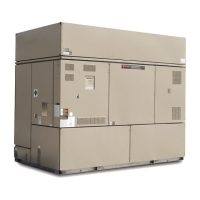





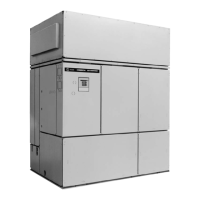

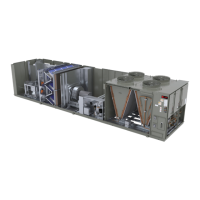
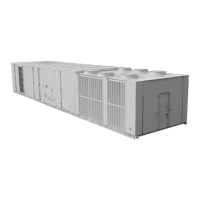
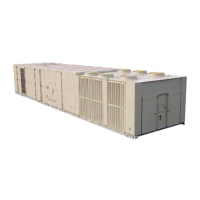
